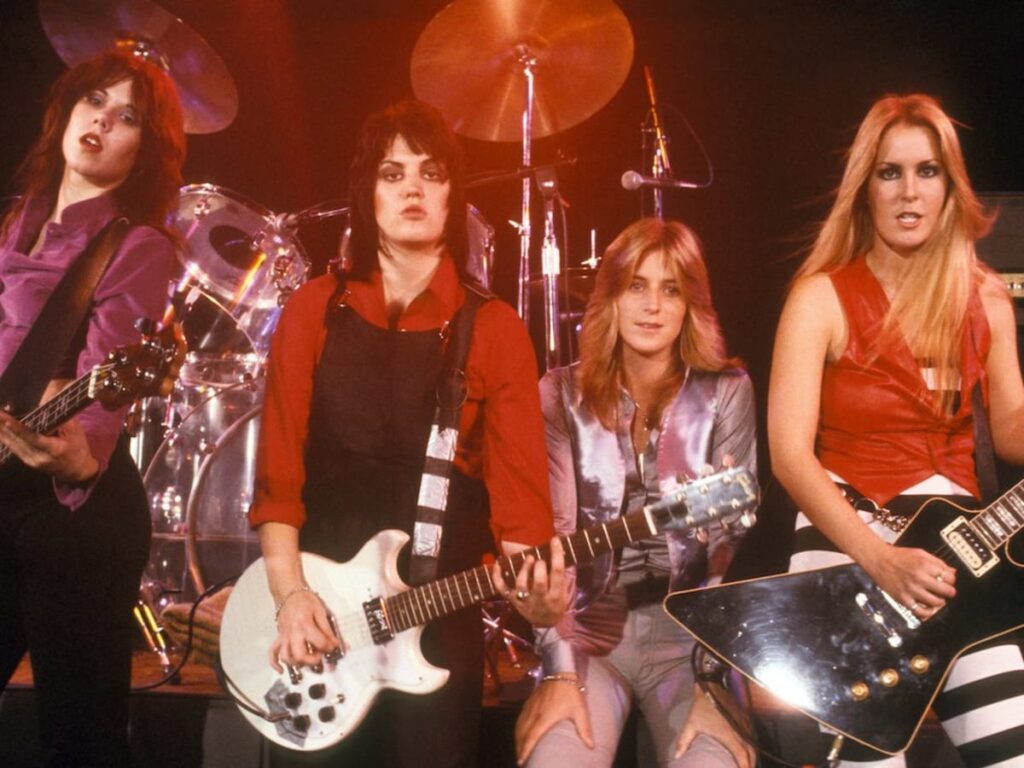Walking around a record store, listening to the radio, or checking out the lineups of rock festivals, you get the obvious feeling that rock music is still heavily dominated by male acts, with very few females taking center stage in the scene.
But do the numbers support this feeling?
According to an article published in The Guardian in 2017, over two-thirds of live acts in the UK are male only, and only 9% are female-only acts (half of which are solo artists)[i]. In Australia the numbers are similar: only one in five members of the Australian Performing Rights Association are women, and 61% of the artists played on Triple J are male-only bands or male solo performers (Triple J is a government-funded, national Australian radio station intended to appeal to listeners of alternative music)[ii]. And in the Rock & Roll Hall of Fame, less than 8% of inductees are women (7.7% to be precise).
No doubt, the numbers are grim. Julian Schaap, a Dutch sociology assistant professor devoted his dissertation to studying why rock is white male. “Rock is a very ‘white’ [and male] music style – something that people within the genre hardly seem to be aware of. The paradoxical thing is that … many of the pioneers of rock ‘n roll were African Americans – and many of them women.”
Rock music is one among many fields in which we see a wide difference in female and male representation: males are more likely to take center stage, be it in politics, business, or the arts. Yet although the gap between men and women is notable in many industries, the numbers seem to hint at an even larger gender gap when it comes to rock music (in 2019, women were 36.6% of physicians in the USA and 37.4% of lawyers, while they had up to 9% representation in the rock scene). What can explain this large gap?
Different messages for girls and boys growing up

Gender is one of the strongest identities enforced on us by society, training kids from a very young age to know what is considered feminine and what is considered masculine. When I was a kid, it was already okay for girls to become scientists, but not many other things, such as soccer players or rock musicians. I discuss this in-depth in my post about different messages for boys and girls.
As these identities are enforced so vigorously, most of us rarely come to doubt what we know to be feminine or masculine, and rarely ever realize that the codes of female and male conduct can be quite random and arbitrary.
Take the color pink for example. The color pink, which nowadays is considered a feminine color, used to be a color representing masculinity up until the 1920s. “An article titled ‘Pink or Blue,’ published in the trade journal The Infants’ Department in 1918, wrote that the generally accepted rule is pink for boys and blue for girls. “The reason is that pink being a decided and stronger color is more suitable for the boy,” it said. In fact, up until the 20th century pink was considered a masculine color. In old catalogs and books, pink was the color of choice for little boys.[iii]
Then there are high-heel shoes, that were for years the sole domain of men. In fact, in all of human history, men have been wearing heels for far more time than women, starting at the 11 century AC. It started with practical horsemanship shoes, as high-heel shoes fit nicely into a stirrup. “When the soldier stood up in his stirrups, the heel helped him secure his stance so that he could shoot his bow and arrow more effectively.”[iv] But heels are practical for horse riding and impractical for walking, so they turned into a status symbol – those men who walked on heels indicated to others that they were wealthy and powerful, as they had horses and carriages and didn’t have to walk much.

With the enlightenment movement, men started to put more emphasis on education rather than privilege. Men’s fashion shifted towards more practical clothing. “It was the beginning of what has been called the Great Male Renunciation, which would see men abandon the wearing of jewelry, bright colors, and ostentatious fabrics in favor of a dark, soberer, and homogeneous look. Women, in contrast, were seen as emotional, sentimental, and uneducable. Female desirability begins to be constructed in terms of irrational fashion, and the high heel – once separated from its original function of horseback riding – becomes a primary example of impractical dress.”[v]
Pink and heels are just a couple of examples out of many of what society these days believes to be feminine. Did the history facts above surprise you? Did you think of pink and heels as feminine your entire life without giving it a second thought?
The strong pressure to conform to our times’ gender identities hurts both men and women, and in our specific debate about women in rock, is one of the culprits for the absence of women from the rock scene. Playing rock guitar and drums was, and probably still is, more encouraged in boys than in girls. That is why even when there are women in rock bands, more often than not they are the lead singer, whereas females playing instruments, or all-female rock acts are quite rare.
Depending on the sub-genre, rock can be quite aggressive, while girls are taught to not display aggressive attitudes. (Whenever I hear someone say that by nature females are less aggressive than males, I remember the stats on bear attacks – the most frequent and deadliest bear attacks are when humans encounter a female bear with cubs. So females can be no less aggressive than males, even though in our human conditioning aggressiveness is more tolerated in males.)
The lack of women in rock generates a feedback loop – most of the rock acts you come across are established male acts. Children look up to the role models they see around them, and if there aren’t many girls/women in rock, a girl is likely to conclude that playing rock music is a “guy thing”, and will steer away from rock, as she subconsciously wants to conform and get the approval of society.
Confidence level

On average, girls have to feel they really know something well to display it publicly. They experience more self-doubt, and demand of themselves a higher level of expertise before they put themselves out there. We see this behavior starting as early as elementary school, as boys raise their hands to answer a question in class more often than girls. We see it in the adult playing field, as women are less likely to volunteer to give a presentation or to get on stage and play an instrument. Boys, on average, are encouraged to put themselves out there and take risks.
This makes recruiting an all-girl rock band especially challenging. Girls are unlikely to answer an ad to join a band unless they feel like pros, and those few pros are of such a high professional level that they are already fully booked with other time-consuming musical projects.
At open mics, it is far more likely to see a man performing without knowing what he’s doing than it is to see a woman doing the same. Most women performers in these events are pros.
The rock star’s looks
Much more weight is given to a woman’s external appearance versus that of a man, and this is especially evident in the careers of entertainers and other public personas. On average, in order to become a wild success, a woman has to be good at what she does and also good-looking, while men can get away with just being good at what they do. Wouldn’t it be refreshing to see more successful female rock bands, whose members don’t fit the beauty ideal depicted by the media?
Youth takes center stage in a girl-musician appearance. Many female musicians feel their clock is ticking. I still look young, but for how much longer? Why are so few women given the admiration lifespan that Mick Jagger, Steven Tyler, and James Hetfield all get? How many grey-haired female rock stars can reach and keep massive success?
Holistic and balanced choices

Women are underrepresented in leading roles such as Fortune 500 CEOs, top movie directors, top musicians, top surgeons, best chefs, etc. Without undermining the barriers stopping many women from reaching top positions, one explanation given for the absence of women from top positions is that on average, women have a more holistic worldview and are less single-minded. But that too, perhaps is a product of nurture – women and girls are encouraged to excel in holistic tasks such as housekeeping, raising a family, or forming social bonds, while men and boys are encouraged to choose a goal and stay laser-focused on it. As stated previously, this takes a toll on both men and women whose natural inclinations don’t align with these societal expectations.
Nurture or nature, from what I’ve seen, women tend to be more well-rounded. Yes, they often like their jobs and want to succeed in them, but most of them also want to leave significant time for friends, family, leisure, and hobbies. And that is without mentioning the cases in which childrearing and home chores are handled primarily by the woman, leaving her less time and energy to pursue her career.
In a world that pushes us toward specialization, there is a price to pay for not being single-minded. As of the moment of writing this paragraph, I haven’t been able to accomplish outstanding success (at least not in the way our society defines success – a spectacular career, a best-selling book, a platinum record_. On good days I tell myself that success, as defined by society, is not really important to me, and on bad days I blame myself for not making better career choices.
Taking risks

Somewhat correlated to the previous points, men tend to take more risks than women. This seems to have both nature and nurture roots. Thousands of years ago when we were hunters and gatherers and lived in the savannas, once males mated with women, their survival became much less important than that of women, who had to carry the babies inside of them, breast-feed them, and almost always be the main caregivers. Even as fathers became more and more involved in the lives of their children, and humans gravitated toward monogamy, the survival of the mother remained more biologically critical to the survival of the child than the survival of the father.
It’s not to say that women don’t take risks – they obviously do – but more calculated risks rather than impulsive and irrational ones. If you need further proof that women are more rational and don’t take as many uncalculated risks, check out these three stat sources:
- The Darwin awards – a mockery award awarded to people for dying in stupid ways – you will see that there are hardly any women represented in the list.[vii]
- Road accidents – even when adjusting the stats for the fact that women on average drive less mileage than men (for example as there are fewer female truck drivers), males on average are involved in much more car accidents. In terms of causing accidents, in New York for example, 4 out of every 5 road accidents is caused by a man. [viii]
- The stock market – studies show that women are better stock market investors – the risks that they take are more calculated than those of their male counterparts, resulting in an overtime better return. [ix]
How does the male/female risk-taking behavior relate to women in rock you may ask? Well, playing in a rock band requires taking risks: you risk your financial future if you decide to dedicate your life to music rather than follow a more secure career path. If you go for a music career, it is absolutely possible that you will struggle to make ends meet, while if you choose to be a physician or an accountant, it is practically guaranteed that you will make a nice living. Then there are the risks and discomforts of spending many hours on the road, sleeping in a van, succumbing to a diet of junk food, experiencing harassment from fans, haters, gatekeepers in the music industry, and more.
Pregnancy and childrearing

Unlike female musicians, male musicians have control over how much expanding their family will influence their musician lifestyle. When men have young kids, they might not tour as much, taking a relaxed time until their kids grow up, or they can arrange their tours so they visit home often enough. For women, the situation is quite different. Plans of getting pregnant and having a family are enough to influence a women’s professional choices in the present. Women have to ask themselves questions such as: is it worth my while to give a huge push to my career and become a touring musician if I’m planning on having kids in the next couple of years and will be off the road for a few years? Should I opt for something I can do from home, such as writing songs for others? If I now join a new band, can I commit to touring? The answers to such questions are complex and often depend on the availability of your partner and other support systems you have, as well as on your attachment needs as a mother. Your attachment needs as a mother often can’t be predicted before you have your first child, as well as the emotional and physical needs of your child.
And there is pregnancy itself, which imposes changes to your act. Your voice will change, as well as your energy levels and your ability to hop around on stage. Climbing up a narrow staircase to get on a dark stage full of instruments is hazardous any day of the year, and all the more so when you are pregnant.
So there are fewer women in rock… so what?
- As rock is a male’s game, there are going to be some built-in gender-related hardships. Be prepared and don’t let them tip you off.
- Playing rock is, in a way, a feminist mission. You don’t even have to “make it”, it is enough for other women and girls to hear that you play, or see you in an open mic, for them to be inspired.
- Whether you are a male, female, or other, as a listener, make it a point to include female musicians in your playlists.
If you want to learn more about women in rock I suggest that you read this excellent book by Lisa Robinson – Nobody Ever Asked Me About the Girls: Women, Music, and Fame.
Resources
[i] https://www.theguardian.com/inequality/2017/oct/12/tonights-live-music-acts-will-mostly-be-male-only-whats-holding-women-back
[ii] https://theconversation.com/harder-faster-louder-challenging-sexism-in-the-music-industry-58420
[iii] https://edition.cnn.com/2018/01/12/health/colorscope-pink-boy-girl-gender/index.html
[iv] https://www.bbc.com/news/magazine-21151350
[v] https://www.bbc.com/news/magazine-21151350
[vi] https://www.sciencedaily.com/releases/2013/03/130326101616.htm
[vii] https://darwinawards.com/
[viii] https://www.iihs.org/topics/fatality-statistics/detail/males-and-females
[ix] https://www.reuters.com/article/us-money-investing-women-idUSKBN18Y2D7